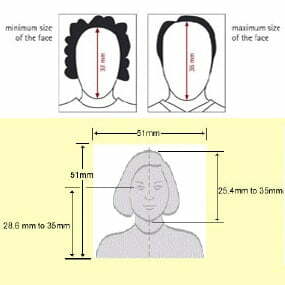
High quality and fully compliant Passport and Visa photography
Passport and Visa photos fall into the category of a ‘necessary evil’ for most people. They are never going to be your favourite photo of yourself, particularly since such strict biometric standards were introduced, it certainly isn’t the professional portrait way you take pictures of people normally! However, while you need to ensure at all times that your photo complies with the national government specifications around the world, there are a number of areas that can be used in the professional studio environment to improve the aesthetic results.
Passport booths are obviously a very convenient option, particularly out of hours, but they can be problematic if you are looking for pictures of a baby or small child that won’t keep still or can hold their head up. Many passport photo booths can not deal with a non-standard UK passport image, such as a Canada, USA or India specification. Biometric system requirements can be very specific in terms of head placements, skin percentages and background requirements.
We use worldwide standard software that is kept updated with the latest international requirements and automatically checks each photo as it is placed into the relevant country’s template to ensure that it meets all standards guaranteeing acceptance by the authorities. We have never had a photograph rejected from a passport or visa application through using this system.
Biometric ISO/IEC-standard 19794-5
Passport photographs must comply with the International Civil Aviation Organisation (ICAO) standard ISO/IEC 19794-5. This means that any photograph must not be edited in anyway and comply with specific measurements e.g. controlling where the head resides in the frame, where the eyes are placed and the percentage of frame filled. Whilst we are governed by these standards we can apply professional photographic standards to the lighting used, camera and lens and angle. Using a photobooth will mean your picture is subject to harsh unflattering lighting, and wider unflattering focal length lens. Using a booth also means you need to be ‘ready’ and you don’t get the advantage of a professional photographic eye looking at the results before they are printed, booths only care about being complaint.
Some photographers offer free ‘air-brushing’ of photos in a way to suggest you will look better then in a normal passport photo. This is actually against the law and is technically fraud, as the photos must not be interfered with. The authorities will certainly use imaging technology to detect photo manipulation which will result in your picture being refused.
We print all passport photos in compliance with the standard and we do this while you wait. Our passport picture services only takes 5-10 minutes from beginning to end and you can rest assured that not only are you getting the best photo you can from the process, but that it will be accepted by over 180 countries who adopt the standard. This is essential if your application is urgent and last-minute!
#passportphotographer #passportphotography #passportphotographystudio #passportstudiocrawley
https://www.visualchaosstudios.co.uk/crawley-professional-passport-photos/
Comments